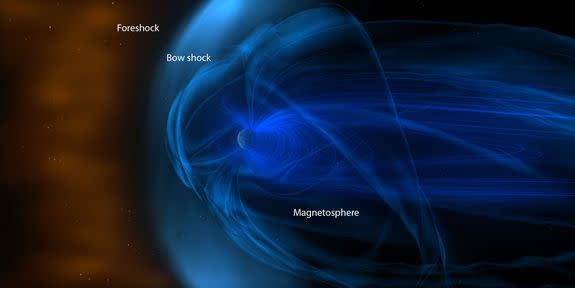NASA discovers mysterious electron superhighway above Earth

Some electrons are speeding above Earth's surface at nearly the speed of light, and NASA isn't sure why.
According to a new study, the tiny, charged particles were found accelerating to high speeds in an unexpected part of space, farther from Earth than previously realized.
The region these fast electrons were found in, known as the foreshock, is the part of the solar system where charged particles streaming from the sun are thought to be reflected back from Earth's magnetic field toward the star.
SEE ALSO: NASA is firing lasers on Mars — here’s why
Until now, however, scientists didn't think the region could speed up particles to the degree that was observed
“This is a puzzling case because we’re seeing energetic electrons where we don’t think they should be, and no model fits them,” David Sibeck, a co-author of the new study published in the journal Physical Review Letters said in a statement.
“There is a gap in our knowledge, something basic is missing,” Sibeck said. The study evaluated data from a NASA program known as THEMIS — a mission involving five identical space probes tasked with studying Earth’s auroras and the radiation environment around our planet.
Human space travel implications
Charged particles streaming from the sun out into the rest of the solar system can harm satellites in orbit and even people living in space. That radiation needs to be understood in order to guard against its worst effects.
“This affects pretty much every field that deals with high-energy particles, from studies of cosmic rays to solar flares and coronal mass ejections, which have the potential to damage satellites and affect astronauts on expeditions to Mars,” Lynn Wilson, another author of the study, said in the statement.
Charged particles speeding toward Earth from the sun encounter an area of space called the "bow shock." That region is something like a protective zone that helps shield our planet from the solar wind.

Image: NASA
The bow shock has a magnetic field within it, which slows high-energy particles down, according to NASA. Most of those particles are diverted away from Earth, but some do bounce back toward the sun, creating the foreshock region, where the electron superhighway was discovered.
Before this new research, scientists knew that electrons in the foreshock could move quickly. Researchers have suggested that the particles speed up when they move across the bow shock multiple times, NASA said.
But the new study has added to NASA's understanding of how these electrons accelerate.
It seems as though some kind of electromagnetic activity in the foreshock itself might be accelerating the particles to unexpected speeds, the study suggests.
